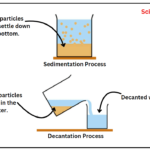What is Limiting Reagent | Definition, Example
The limiting reagent, also known as the limiting reactant, refers to the substance or reactant that is completely consumed or used up during a chemical reaction. Many a time in chemistry, a chemical reaction is carried out with the amounts of reactants that differ from the amounts as needed by a balanced chemical reaction.
In such situations, one reactant is present in a larger amount than the amount required by a balanced chemical reaction. In other words, the reacting substances are not present in exactly the same amounts as required by the balanced chemical reaction. Some reacting substances may be present in lesser amounts, while some other may be present in amounts greater than stoichiometric amounts.
The reactant or reacting substance which is present in the least amount gets used up after sometime and after that further reaction does not occur whatever be the amount of the other reactants. The reactant, which gets used up first, it restricts or limits the amount of product formed. Therefore, it is called the limiting reagent.
Thus, we can define it as “The reactant or reacting substance which gets consumed first in the reaction is called limiting reagent”. The other reactants which are present in excess than stoichiometric amounts are called excess reagents. In performing stoichiometric calculations, you should keep this limiting reagent concept in mind.
Example of Limiting Reagent
Consider the following reaction below:

From the above chemical reaction, it is clear that 2 mol of hydrogen (H2) reacts with 1 mol of oxygen (O2) to form 2 mol of water (H2O).
Now let us consider two cases.
Case 1: Consider a reaction mixture consisting of 2 mol of hydrogen and 2 mol of oxygen. According to the reaction stoichiometric, 2 mol of hydrogen needs only 1 mol of oxygen. So, in this case, only 1 mol of oxygen is consumed and 1 mol of oxygen is left and unreacted. Thus, 2 mol of hydrogen is completely used up and produced 2 mol of water. So, hydrogen is limiting reagent here.
Case 2: Let us consider another reaction mixture consisting of 3 mol of hydrogen and 1 mol of oxygen. According to the reaction stoichiometric, 2 mol of hydrogen needs only 1 mol of oxygen to form 2 mol of H2O. So, in this case, the oxygen is completely consumed, but 1 mol of hydrogen is left and unreacted. So, oxygen is limiting reagent in this case.
Example of Limiting Reagent Calculation Step by Step
Example 1:
3 g of hydrogen reacts with 29 g of oxygen to form water. Answer the following questions below.
(1) Which is the limiting reagent in the chemical reaction?
(2) Calculate the maximum amount of water formed?
(3) Calculate the excess amount of reactant, which remains unreacted in the reaction?
Answer:
The chemical reaction is: H2 + O2 → H2O
The balanced chemical reaction: 2H2 + O2 → 2H2O
Mass of H2 = 3 g (given)
Mass of O2 = 29 g (given)
No, of moles of H2 = Mass / Molar mass = 3 g / 2.016 gmol-1 = 1.49 mol
No. of moles of O2 = 29 g / 32.0 gmol-1 = 0.906 mol
According to balanced chemical equation,
2 mol of H2 reacts with = 1 mol of O2
1 mol of H2 reacts with = 1/2 mol of O2
1.49 mol of H2 reacts with = (1 * 1.49) / 2 = 0.745 mol of O2
2H2 + O2 → 2H2O
2 mol 1 mol 2 mol
1 mol 1/2 mol 1 mol
1.49 mol 1.49 / 2 mol = 0.745 mol 1.49 molThus, 1.49 mol of hydrogen (H2) reacts with 1 mol of oxygen (O2). In this case, the whole of hydrogen is completely consumed. But 0.161 mol of oxygen remains unreacted because 0.906 mol of oxygen is taken in this reaction.
(1) So, no doubt. Hydrogen is limiting reagent.
(2) The maximum amount of water (product) formed = 1.49 mol which is equal to hydrogen gas.
(3) Amount of oxygen left or unreacted = 0.906 mol – 0.745 mol = 0.161 mol
Common Mistakes in Limiting Reactant Problems
While dealing with limiting reagent problems, students often make some common mistakes. These include:
- Failing to balance the chemical equation correctly
- Using incorrect molar masses or conversion factors
- Forgetting to convert between units (e.g., grams to moles)
- Assuming one reactant is always the limiting reagent without proper calculation
- Neglecting significant figures in calculations
Avoiding these mistakes requires careful attention to detail and a solid understanding of stoichiometry principles.
Practical Applications of Limiting Reactant
The concept of the limiting reagent finds applications in various fields:
- Pharmaceutical industry: It helps determine the optimal amount of reactants required to produce medications efficiently.
- Environmental chemistry: It aids in understanding the reactants’ availability and their impact on the environment during chemical processes.
- Manufacturing processes: Limiting reagent calculations are crucial in industries such as petroleum refining, food processing, and materials synthesis, ensuring resource optimization and reducing waste.
Frequently Asked Questions on Limiting Reactant
Q1: Can the limiting reagent change in a chemical reaction?
A: Yes, the limiting reagent can change in a chemical reaction because it depends on the stoichiometric ratios and the actual amounts of reactants present. Different initial amounts of reactants can lead to different limiting reagents.
Q2: What happens to the excess reagent in the chemical reaction?
A: The excess reagent is not completely consumed and remains unused after the reaction is complete. It is typically separated and can be recovered, recycled, or disposed of appropriately.
Q3: How does the limiting reagent affect the reaction rate?
A: The limiting reagent does not directly affect the reaction rate. It determines the maximum amount of product that can be formed but does not affect the reaction’s speed or rate of progress.
Q4: Is it possible to be more than one limiting reagent in a chemical reaction?
A: No, there can only be one limiting reagent in a chemical reaction. The reactant that gives the least number of moles of product based on the stoichiometric ratios is considered the limiting reagent.
In this tutorial, we have explained the concept of the limiting reagent or reactant with great examples. Understanding the concept of the limiting reagent is crucial for students. Hope that you will have understood the basic points of limiting reactant and enjoyed this tutorial.
Thanks for reading!!!







